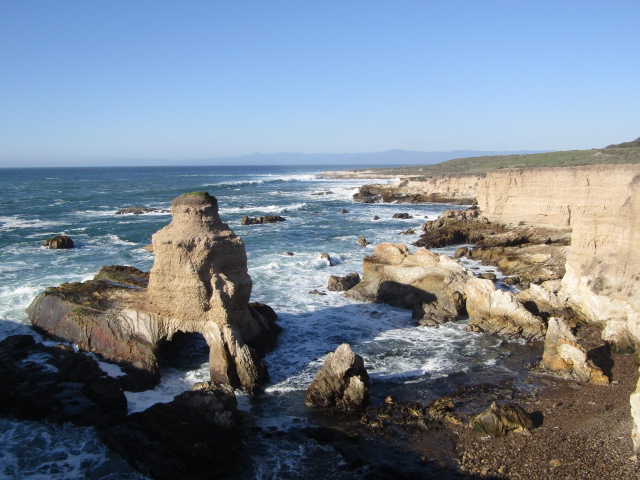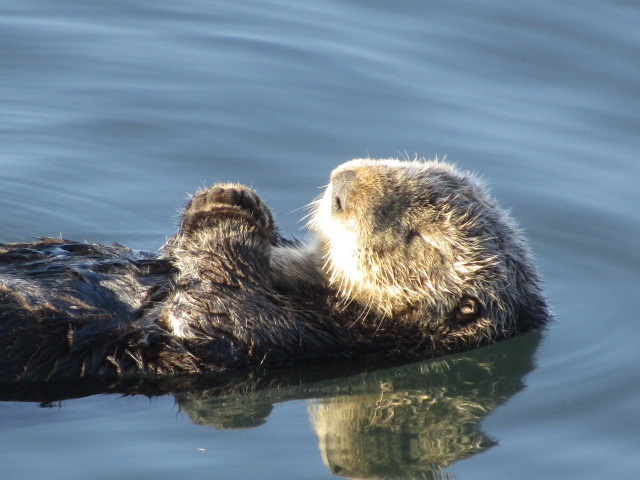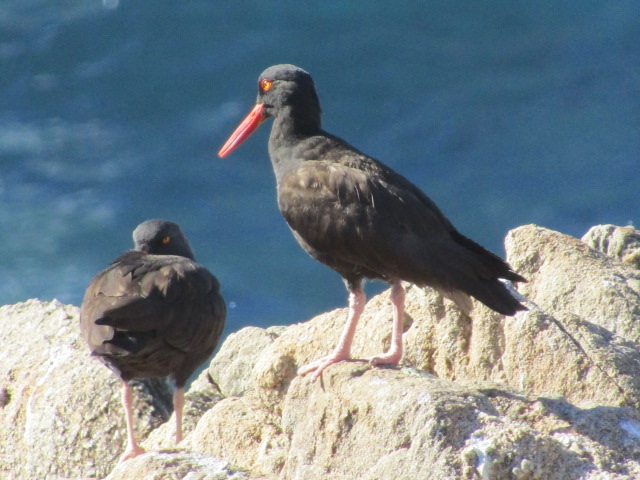Bonnie Wood

Many birders travel to Florida or Texas during the winter for some winter birding. This year, seeking sun and warmer temps, my partner and I opted for the central California coast. Mind you, we chose this location with some mistaken notions about where to find sun. Locals whom we met on hiking paths greeted us by saying, “Great weather! No fog!” In our minds, we thought, “Well, yeah, that’s why we came here.” But apparently we were fabulously lucky with weather. It was clear, sunny and in the high 50s or 60s every day.
The hiking and birding were glorious experiences.
Morro Bay, once a gritty fishing town, has grown into a significant tourist destination. It is also an Important Bird Area (IBA); its estuary, beaches, and protected waters are magnets for overwintering birds. The very first day we were there, on the mile and one-half loop Marine Estuary Trail, we saw many many (hundreds? thousands?) Marbled Godwit, Long-Billed Curlew, Willet, Avocet, Least Sandpipers, Black-Bellied Plover, Brown and White Pelican, Double-Crested Cormorant, Great and Snowy Egret, Eared Grebe, loons, other shorebirds and ducks familiar in Western Washington, and more.
Off the water, many birds who are winter residents in Western Washington showed themselves: raptors, sparrows, chickadees, juncos, doves, Townsend’s, Yellow-Rumped, and Orange-Crowned Warbler, and more. Other birds less common (or never) in Western Washington’s winter season included Brewer’s Blackbird, Lesser Goldfinch, Northern Mockingbird, Black and Say’s Phoebe, Western Kingbird, and California Towhee, among others.
A birder will easily find over 100 species of birds in Morro Bay at this time of year, perhaps in a few hours!
We encountered many California birders intent to spot a couple of Bald Eagles hunting in the estuary this year. They told us Bald Eagles are rarely present in Morro Bay. Privately, we, used to seeing Bald Eagles, thought, “Huh.”
So birders were gleeful at Sweet Springs Audubon Preserve in Los Osos, on the other side of the bay from Morro Bay, to see a big beautiful Bald Eagle hunting coots and grebes in the low tidewater. While we were there watching the eagle, Forster’s Terns also hunted. A humongous flock of Brant Geese wheeled through the skies to eventually land far out in the bay. Oak Tit and Nuttall’s Woodpecker gamboled among trees at the preserve. At the Elfin Forest mile-long boardwalk loop, among the preserve’s trees and shrubs, Black-Chinned and Anna’s Hummingbird and California Thrasher foraged.
It was our turn to be gleeful when local birders showed us a Burrowing Owl in a sheltered little cave in town at Morro Rock itself (the “Rock”). They also reported Rock and Canyon Wrens considering nesting in the rock, though we did not spot or hear those in the short times we were there.
In Morro Bay, it is important to note, one would have to work really hard NOT to see sea otters, seals, and sea lions. Sea otters are legion and often congregate right off the waterfront “embarcadero,” where the water is warm and protected. In fact, by Tognazzini’s dockside restaurant, the basin beside the pier has been dubbed the “Sea Otter Nursery,” because new mothers will bring their pups, nap, and hang out. It’s hard not to overuse the word “cute,” but honestly…is there another word?
Morro Bay State Park protects some wonderful hill hiking paths as well as the estuary, bay, and beaches. In Los Osos, Montana de Oro State Park boasts hill paths, too, yet our favorite walk was the five-mile round-trip Bluff Trail, which followed the coast’s in and outs atop the headlands, high above jagged rocks and crashing foamy seas. Off shore, on guano-covered rock islands, Brant and Pelagic Cormorants, diverse gulls, Black Oystercatchers, and Black and Ruddy Turnstones perched. At low tide, seals lolled on flatter rocks. Surf Scoters and Sea Otters hunted in the breakers. It’s a spectacular place.
Another spectacular walk is north of Morro Bay a bit: the Estero Bluffs Trail. Stretching from the small town of Cayucos for about four miles, it also runs on the top of cliffs and headlands and fills one’s eyes and heart with fantastic sea and coastscapes. Water Pipit, sandpipers, and turnstones foraged among the rocks at low tide. Red-Breasted Mergansers hunted in sheltered waters among the rocks. Royal Terns, gulls, and cormorants crowded a huge rock island offshore. Snowy Plovers, almost invisible, huddled out of the breeze on the high beach at the trail’s northern end, while a Loggerhead Shrike darted among scrub in the dunes.
Just a bit farther on the coast then, beyond the Estero Bluffs Trail, lies Harmony Headlands. The two-mile long walking path there, through what was once ranch land, leads to more fantastic coastscapes. Horned Larks gathered together in the meadows. Diverse sparrows sang. In a small freshwater pond, Gadwall, Northern Shoveler and more floated serenely. We spotted a Hermit Thrush.
In the hilly neighborhoods of Cambria, north about twenty-two miles from Morro Bay, Acorn Woodpecker, Wild Turkey, and Black-Tailed Gnatcatcher are easy to find. The Fiscalini Ranch Preserve has, yes, more wonderful walking paths, in pine woods and atop the headlands. We passed a Cooper’s Hawk busy tearing apart some poor creature in plain view in one pine tree.
A bit farther north, hundreds of Elephant Seals haul out on the beaches three times a year. This time of year, mothers birth pups and males defend their harems. One must go to see – and hear the noise!
Moss Landing Estuarine Research Center’s several miles of hiking trails and nearby associated birding sites presented diverse and numerous waterfowl, including Black-Necked Stilt and a small flock of Snow Goose. Elkhorn Slough, like Morro Bay, is a rich estaurine and riparian ecosystem. See www.elkhornslough.org/birding for more detailed descriptions of birding locations in this area.
Finally, inland, in winery-rich Paso Robles, Western Bluebirds and White-Breasted Nuthatches in the oak trees delighted us.
On one display board we passed, I learned that work is afoot to create a continuous north-south hiking trail the entire California coast, a path parallel, if you will, to the Pacific Crest Trail. Based on our experience exploring, we can attest that large stretches of the coast trail are already protected and in place.
Towns in the Central Coast region offer ample hotel and rental lodging. Online, it’s easy to find guides to birding locations and walking and hiking routes. Kayak rentals in Morro Bay and Elkhorn Slough are worth every penny. Go sometime: the Central Coast will steal your heart.
Photos by Bonnie Wood









